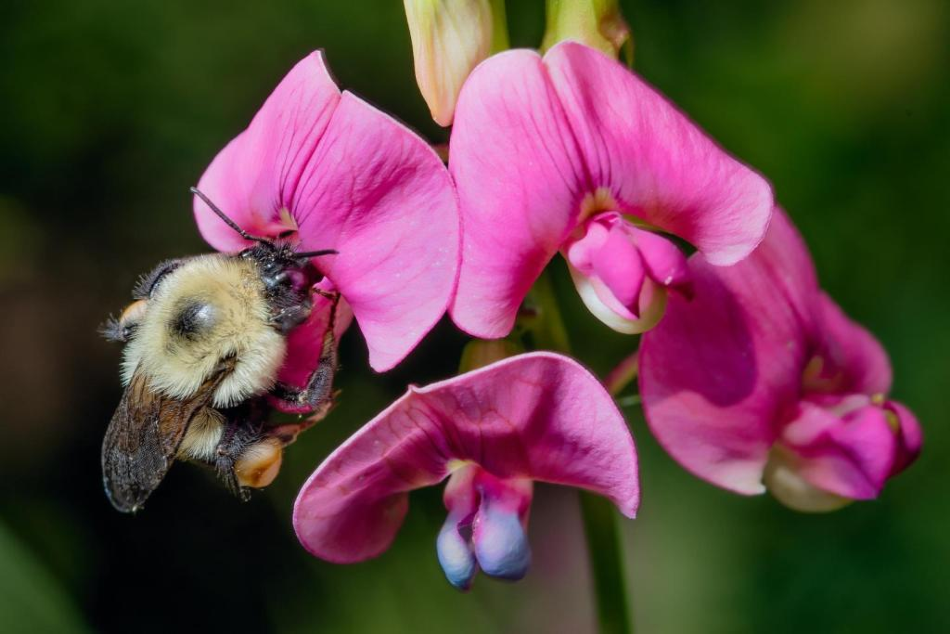Feb 7 2020
When people were children in their times, they would have more likely scoured open fields searching for bumble bees. But today, it is relatively harder for children to spot these insects because they are considerably declining in Europe and North America.
 The common eastern bumble bee. Image Credit: Antoine Morin.
The common eastern bumble bee. Image Credit: Antoine Morin.
A recent research carried out at the University of Ottawa discovered that the chances of a bumble bee population to remain alive in a specific place has reduced by an average of more than 30% in the course of one human generation.
A research team, which included Peter Soroye, a PhD student in the Department of Biology at the University of Ottawa, Jeremy Kerr, a professor at the University of Ottawa and head of the laboratory group where Peter also works, and Tim Newbold, a research fellow at the University College London (UCL), have linked the unnerving concept of “climate chaos” to extinctions. The researchers also revealed that those extinctions started many years ago.
We’ve known for a while that climate change is related to the growing extinction risk that animals are facing around the world. In this paper, we offer an answer to the critical questions of how and why that is. We find that species extinctions across two continents are caused by hotter and more frequent extremes in temperatures.
Peter Soroye, Study First Author and PhD Student, Department of Biology, University of Ottawa
“We have now entered the world’s sixth mass extinction event, the biggest and most rapid global biodiversity crisis since a meteor ended the age of the dinosaurs,” added Peter Soroye.
Massive Decline of the Most Important Pollinators on Earth
“Bumble bees are the best pollinators we have in wild landscapes and the most effective pollinators for crops like tomato, squash, and berries,” observed Peter Soroye. “Our results show that we face a future with many less bumble bees and much less diversity, both in the outdoors and on our plates.”
The scientists noted that bumble bees are vanishing at speeds “consistent with a mass extinction.”
“If declines continue at this pace, many of these species could vanish forever within a few decades,” warned Peter Soroye.
The Technique
“We know that this crisis is entirely driven by human activities,” added Peter Soroye. “So, to stop this, we needed to develop tools that tell us where and why these extinctions will occur.”
The scientists observed climate change and the way it raises the frequency of truly adverse events like droughts and heatwaves, generating a kind of “climate chaos” which can pose a danger to animals. The researchers knew that different species have different tolerance levels for temperature—that is, what is too hot for some species may not be so for others—and eventually created a new temperature measurement.
We have created a new way to predict local extinctions that tells us, for each species individually, whether climate change is creating temperatures that exceed what the bumble bees can handle.
Dr Tim Newbold, Research Fellow, University College London
To test their theory and the latest approach, the researchers used data on 66 different species of bumble bees throughout Europe and North America; this data was gathered over a period of 115 years (1900–2015). Using this data, the scientists compared the present habitat of the bumble bees to where they used to live before, and discovered how the populations of these insects changed over the years.
“We found that populations were disappearing in areas where the temperatures had gotten hotter, added Peter Soroye. “Using our new measurement of climate change, we were able to predict changes both for individual species and for whole communities of bumble bees with a surprisingly high accuracy.”
A New Horizon of Research
The research does not stop here. As a matter of fact, it paves the way to new research horizons to monitor the extinction levels for other kinds of species, like mammals, birds, and reptiles.
“Perhaps the most exciting element is that we developed a method to predict extinction risk that works very well for bumble bees and could in theory be applied universally to other organisms,” indicated Peter Soroye. “With a predictive tool like this, we hope to identify areas where conservation actions would be critical to stopping declines.”
Predicting why bumble bees and other species are going extinct in a time of rapid, human-caused climate change could help us prevent extinction in the 21st century.
Dr Jeremy Kerr, Professor, University of Ottawa
There is Still Time to Act
“This work also holds out hope by implying ways that we might take the sting out of climate change for these and other organisms by maintaining habitats that offer shelter, like trees, shrubs, or slopes, that could let bumble bees get out of the heat,” added Dr Jeremy Kerr.
Dr Kerr continued, “Ultimately, we must address climate change itself and every action we take to reduce emissions will help. The sooner the better. It is in all our interests to do so, as well as in the interests of the species with whom we share the world.”
The study titled “Climate change contributes to widespread declines among bumble bees across continents” was published in the Science journal.
Jeremy Kerr is grateful for the Discovery Grant and Discovery Accelerator Supplement from the Natural Sciences and Engineering Research Council of Canada (NSERC) and funds from his University Research Chair in Macroecology and Conservation at the University of Ottawa. Jeremy Kerr is also supported through infrastructure funds from the Canada Foundation for Innovation.
The partnership was financed by a Royal Society grant to Tim Newbold and Jeremy Kerr, and an NSERC Postgraduate Scholarship award to P.S. to work with J.K.
Tim Newbold was supported by a grant from the UK Natural Environment Research Council (NE/R010811/1) and a Royal Society University Research Fellowship.